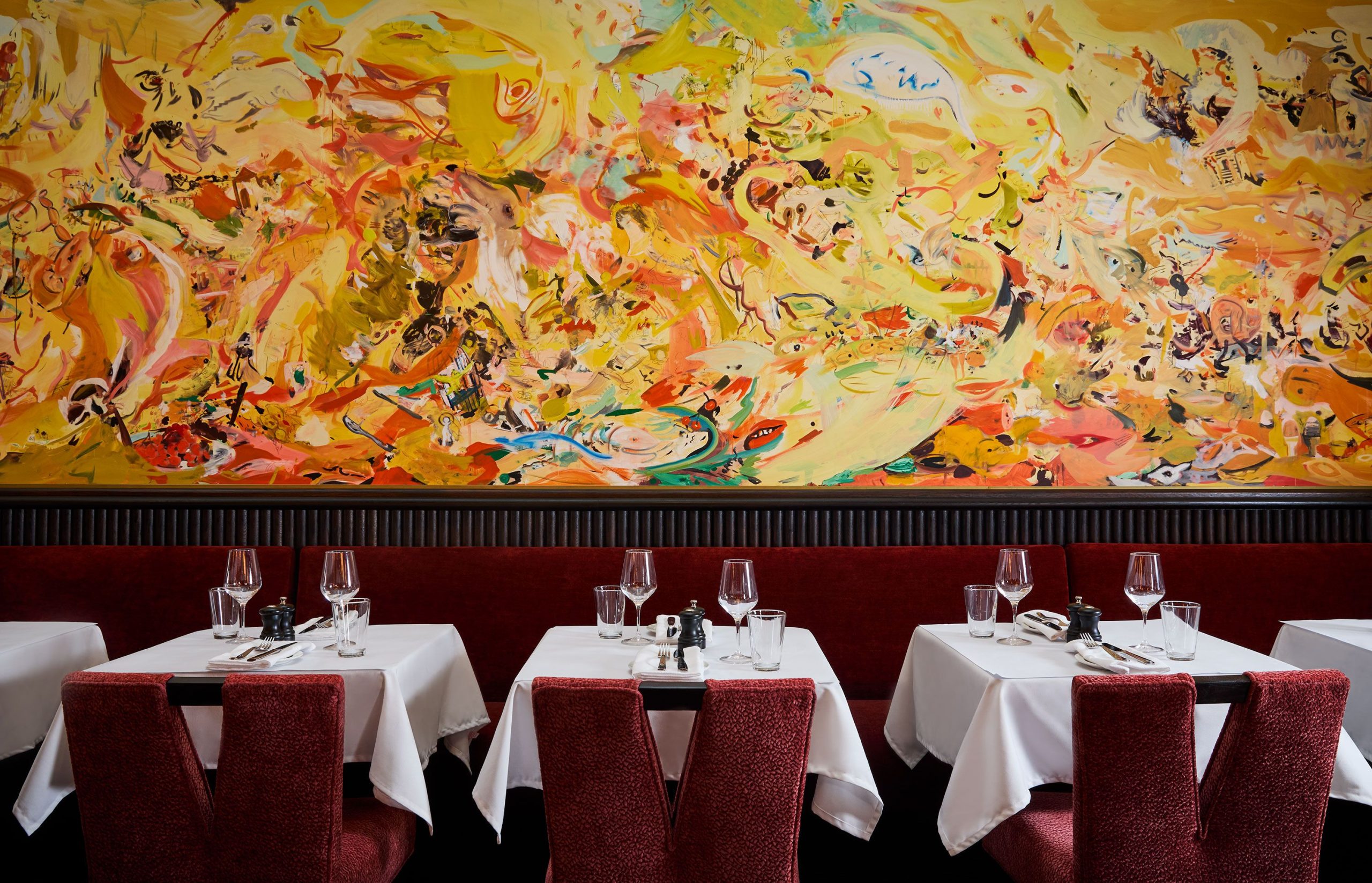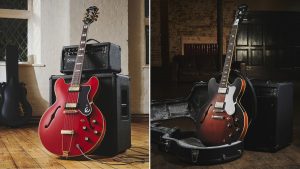
Cecily Brown on the “Unsexy” Art Market and Her New Restaurant Mural: “It Can’t be Moved. It’s Not for Sale.”
British painter Cecily Brown is busy—there was a show at the Barnes Foundation this year, and another will open at the Serpentine next year. Before that was a retrospective at the Dallas Museum of Art, a survey that first opened at The Met. In 2021, she accepted a rare commission to make a work for the historic stairway at the Courtauld Gallery, the London museum brimming with Manet and Van Gogh. The world’s best museums—that’s where she usually shows. But over the summer, Brown’s newest work appeared somewhere unexpected. It’s not in an institution. There’s no wall text, it’s not for sale, it’s not framed, it’s not even really hung. It’s a mural titled Ballad of the Dish and the Spoon (2025), which Brown painted directly on the wall of Chez Nous, a restaurant in the Marlton Hotel, in Greenwich Village.
“There’s a great precedent in New York for art in restaurants,” Brown told me over coffee there on a recent Saturday morning. She was in a seat directly facing the mural, which looms in a partially enclosed back alley, the whorls of flesh tones and cornucopias of heaping platters peeking out from little windows.
Ballad of the Dish and the Spoon (2025)
Painting Cecily Brown. Photograph Annie Schlechter.
It might seem strange that a gigantic, staggeringly good new Cecily Brown work has emerged in a former flophouse where Jack Kerouac hacked out his scrolls, on the same block as Jimi Hendrix’s Electric Lady Studios—though it’s been established that Hendrix is very much a Cecily Brown muse. The work usually comes to, say, Paula Cooper Gallery, where there’s a long line of buyers, collectors who otherwise have to shell out millions for her paintings at auction. And yet Brown herself could not be more pleased. She’s a scholar of the restaurant mural: paintings that enhance the space without completely overwhelming it, and seem like they’ve been there forever. Her favorites: the Maxfield Parrish at the St. Regis’s King Cole Bar, where Dalí and Duchamp used to carouse. The Howard Chandler Christy series in the restaurant at Hotel des Artistes, where Norman Rockwell lived. And, of course, the murals of Bemelmans Bar at the Carlyle Hotel.
“Although I don’t think you can go to Bemelmans Bar anymore—it’s completely ruined,” she said.
She is referring, of course, to the TikTokification of Bemelmans, last discussed in VF by The Walkmen frontman Hamilton Leithauser, a Carlyle lifer.
“It really is,” I said. “Unless you go at 4 p.m.”
“Unfortunately, my ‘drinking at 4 p.m.’ days are behind me, or I would,” she said. “But the mural is wonderful.”
Ludwig Bemelmans, who lived and supped at the hotel for free in exchange for painting its tavern’s walls and lampshades, is best known for inventing the iconic French schoolgirl Madeline, and Bemelmans did depict her on the walls of the bars, walking through Central Park with her classmates. But what Brown likes about the mural the most is the lingering sense of evil, which she says is indebted to Bemelmans’s love of the folktale-influenced German children’s book Struwwelpeter, also an influence of Brown’s.
Not that Upper East Side moms and nannies fully grasp that gothic theme.
“I remember going in there years ago with Charline von Heyl for a Bloody Mary before we went to the Whitney Biennial, and it was full of children. It was full of toddlers,” Brown told me. “It turns out that Bemelmans Bar does a kiddie story time on Sunday mornings. This was before I had kids, but even after I had kids I was like, ‘No, no, it’s a bar.’”
Chez Nous opened in June. I’ve been a few times for dinner, a few times for cocktail parties. It’s wonderful for a late-morning coffee, some eggs—when the hotel guests are already onto their itinerary-marked days, the booths giving way to locals who can linger. There’s few neighborhood spots off Fifth Avenue right above Washington Square Park. There’s the Knickerbocker. Everyone still goes there. This bubble of a block, it’s still a place that feels fully lived in—there’s the New York Studio School, the old nexus of creativity in Greenwich Village. It’s the original site of the Whitney Museum, which drew artists such as the Ninth Street Women, who had their studios steps away.
It’s also where Brown got her start, as she explained in a bit of history unknown to me.
“I studied for six months at the Studio School, which is directly opposite here—inadvertently because I was a student in London and just wanted to come to New York, and that was the place they sent me,” she said, in the English accent she’s retained despite decades spent living in New York. “I found it very conservative and didn’t like it much. But the funny thing is, the only piece of work I made there was a wall drawing.”
Cecily Brown in Vanity Fair’s February 2000 Issue.Todd Eberle.
She likes the neighborhood, and until she moved a few years ago (“I’ve moved slightly out of the neighborhood now, I’m 10 minutes away,” she says), Brown was part of the potent micro-community within a single block of Ninth. Among the notable neighbors were David Kuhn, the book agent, and his partner, the production designer Kevin Thompson. Brown and her husband would often go to their place for their famous dinners, extended sit-downs that evoked the old Village, a heady mix of architects and publishers and movie stars and playwrights, just like the old days—all drawing from the extremely immediate vicinity.
“David and Kevin would give these cocktail parties, and you’d be like, Wow, they have friends from every walk of life, people you recognize, and writers. Very super interesting parties,” Brown said. “One thing that would strike me at any of their parties was that nearly everyone seemed to live in the neighborhood. David and Kevin were obsessed with this fact. They’d be like, ‘Yeah, we know 100 great people within three or four blocks.’”
Amid this milieu Sean McPherson was mulling a reboot of the bistro at the Marlton, the hotel he owned a block away on Eighth, and got the idea to hand the keys over to Kuhn and Thompson. Kuhn had spent a career in magazines and publishing (he was an editor at VF in the ’80s and ’90s) and Thompson is Bradley Cooper’s go-to art director—not exactly restaurant people. But MacPherson went to the same dinner parties that Brown did. He knew it would work.
After the essentials had been ironed out, Kuhn told me, he thought about the feel of the place, the vibe, and his mind went to the artworks on the walls. Ideally, there would be something quite striking, a centerpiece. Kuhn thought of his old neighbor who happens to be one of the world’s most celebrated painters.
Courtesy of Chez Nous.
“They came to me only about six months before it was due to open, saying, ‘Cecily, we’re doing this thing, and we would love, if there’s any chance, to get a painting for the restaurant,’” she said. “Well, I can’t make a painting specifically for you that you could hang. I don’t have anything that’s 30-feet long kicking around.”
But Brown had always wanted to paint a mural on a restaurant, and was just waiting for someone to ask.
“I did say, ‘Well, why don’t I just do something directly on the wall?’”
She had painted a mural in Buffalo a few years back, through Stefania Bortolami’s Artist/City program, and found it liberating to make public work freed from the shackles of the price tag.
“With the greedy, voracious art market, the minute you have a painting these days, the question of price starts swirling around, insurance, and all those unsexy things,” she said. “I don’t want people sitting there saying, ‘Oh, how much is it?’ So by doing it directly on the wall, it completely gets past all that. It can’t be moved. It’s not for sale. It’s never for sale. It actually belongs to me. It’s very freeing.”
It’s also very Cecily Brown, very much in the thrust of her practice as a painter drawn toward the existential question of excess—excess sex, yes, a theme present in her work, but also culinary excess, which crops up quite often. Take Lobsters, Oysters, Cherries, and Pearls (2020), seen at her solo show at The Metropolitan Museum of Art in 2023—heaping platters of seafood spread across a table, begging to be masticated and savored. At Paula Cooper, in 2020, were a series of bravura paintings that dealt directly with gustatory bigness. A lush buffet supper with a woman, partially nude, imbibing. The Splendid Table is a massive triptych showing caught game—geese, ducks, rabbits, deer—ready for slaughter, flame, and feast.
And now she has a work that’s permanently set next to where clientele sip cocktails and dine. Not that it’s some static, fusty thing. Like Brown herself, it’s just too alive to stay as is. It might get some tweaks here and there. Kuhn told me that, the other day, Brown noticed an area that needed a spot of red, so she took her lipstick out of her bag and painted.
“The idea was I could maybe still carry on working on it, like bring my colored pencils and just do a little bit here and there,” she said.
Have a tip? Drop me a line at [email protected]. And make sure you subscribe to True Colors to receive Nate Freeman’s art-world dispatch in your inbox every week.
King Charles Strips His Brother Andrew of “Prince” Title and Royal Housing











